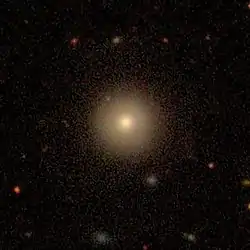| NGC 6044 | |
|---|---|
 SDSS image of NGC 6044. | |
| Observation data (J2000 epoch) | |
| Constellation | Hercules |
| Right ascension | 16h 04m 59.7s[1] |
| Declination | 17° 52′ 13″[1] |
| Redshift | 0.033106[1] |
| Heliocentric radial velocity | 9925 km/s[1] |
| Distance | 143 Mpc (466 Mly)[1] |
| Group or cluster | Hercules Cluster |
| Apparent magnitude (V) | 14.9[1] |
| Characteristics | |
| Type | SA0^0[1] |
| Size | ~100,100 ly (30.69 kpc)[1] (estimated)[1] |
| Apparent size (V) | 0.62 x 0.58[1] |
| Other designations | |
| IC 1172, CGCG 108-110, DRCG 34-93, MCG 3-41-84, PGC 57015[1] | |
NGC 6044 is a lenticular galaxy[2] located about 465 million light-years away[3] in the constellation Hercules.[4] NGC 6044 was discovered by astronomer Lewis Swift on June 27, 1886. It was then rediscovered by astronomer Guillaume Bigourdan on June 8, 1888.[5] NGC 6044 is a member of the Hercules Cluster.[6][5]
See also
References
- 1 2 3 4 5 6 7 8 9 10 11 "NASA/IPAC Extragalactic Database". Results for NGC 6044. Retrieved 2018-01-30.
- ↑ "Your NED Search Results". ned.ipac.caltech.edu. Retrieved 2018-01-30.
- ↑ "NED Query Results for NGC 6044". ned.ipac.caltech.edu. Retrieved 2018-01-30.
- ↑ "Revised NGC Data for NGC 6044". spider.seds.org. Retrieved 2018-01-30.
- 1 2 "New General Catalog Objects: NGC 6000 - 6049". cseligman.com. Retrieved 2018-01-25.
- ↑ "Detailed Object Classifications". ned.ipac.caltech.edu. Retrieved 2018-01-30.
External links
- NGC 6044 on WikiSky: DSS2, SDSS, GALEX, IRAS, Hydrogen α, X-Ray, Astrophoto, Sky Map, Articles and images
This article is issued from Wikipedia. The text is licensed under Creative Commons - Attribution - Sharealike. Additional terms may apply for the media files.